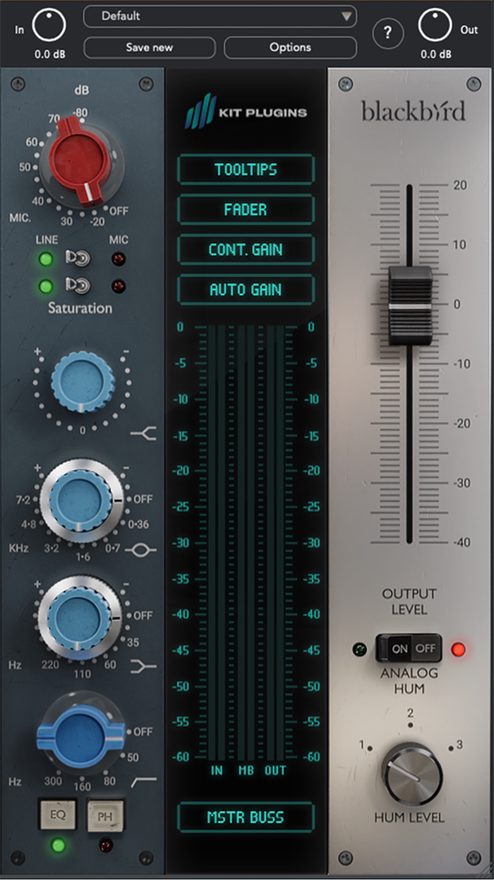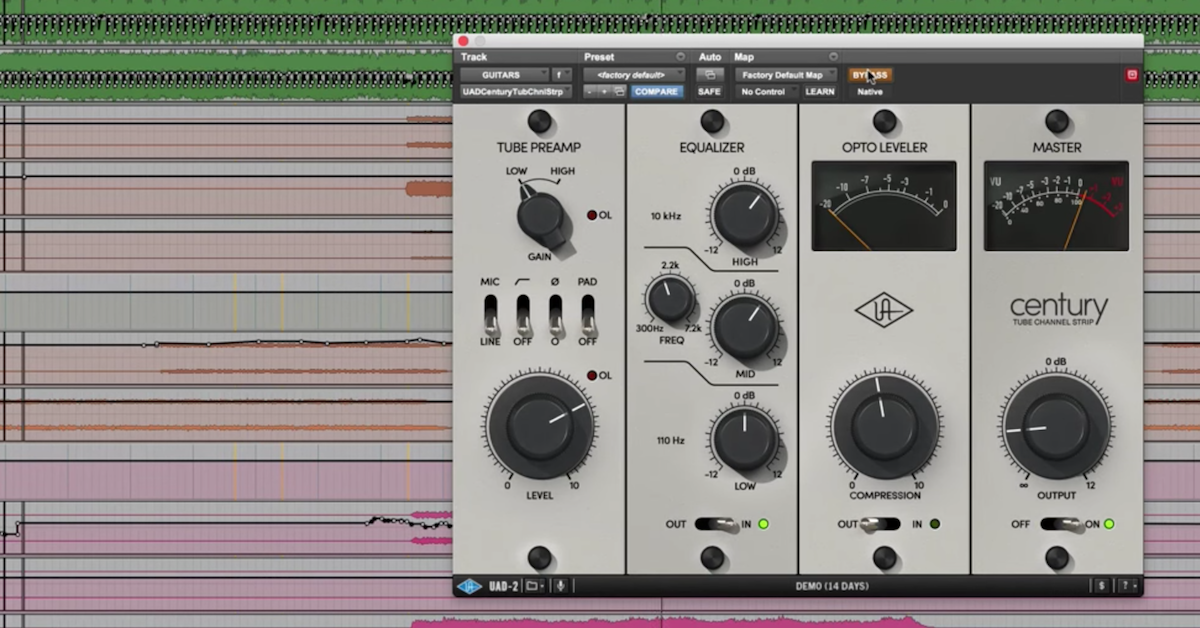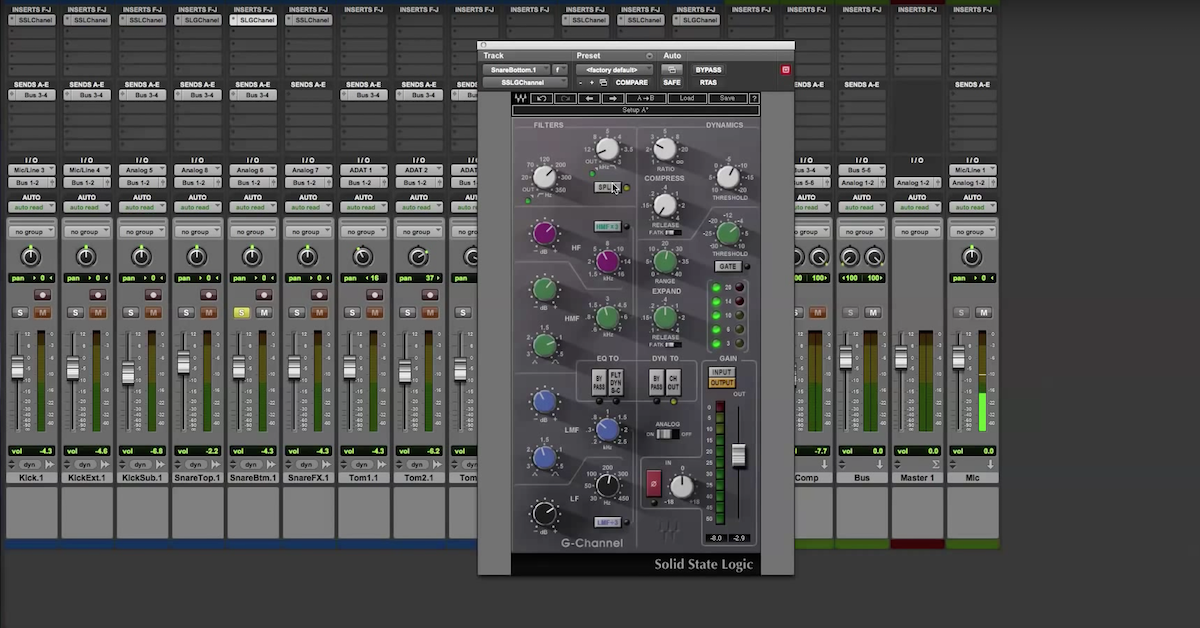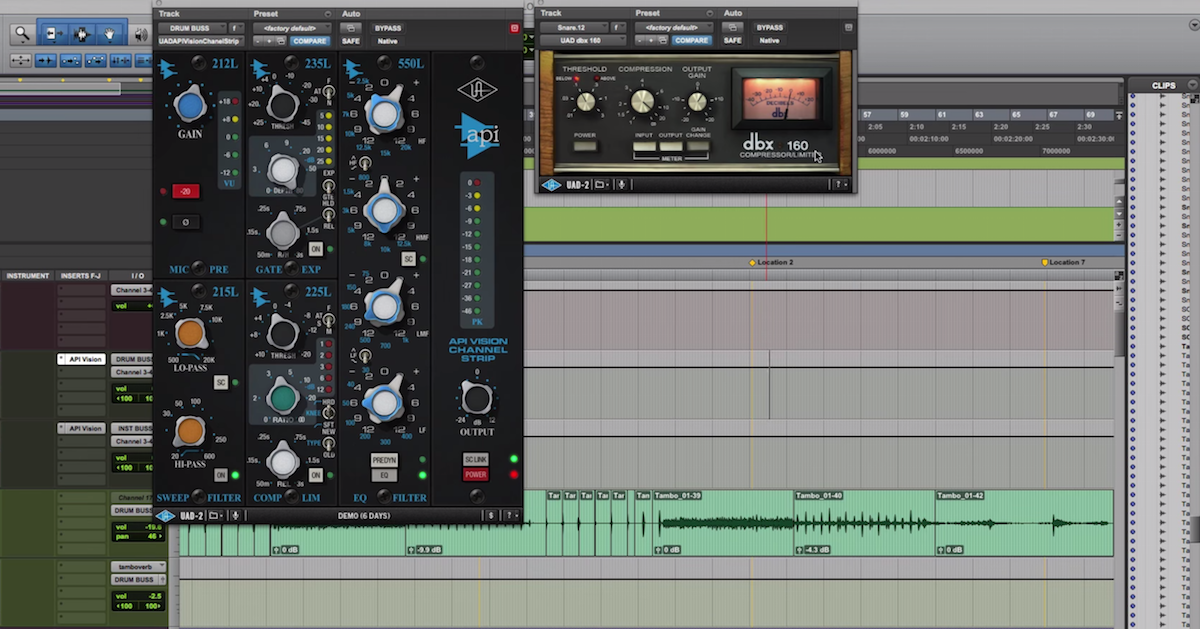14 Favorite Channel Strip Plugins (+ Mix Tips)
Article Content
Before the days of large recording consoles, mixers comprised of modular amplifiers (such as the groundbreaking 610 by Bill Putnam Sr. and Universal Audio, which included a preamp, equalizer, three program outputs and an echo send) were used to send and process individual channels of audio. Technology (and the associated vernacular) evolved, and dedicated recording consoles comprised of individual channel strips were developed and used to record and mix many of the popular records created in the 60s, 70s, 80s and beyond.
Engineers at EMI created the tube-based REDD (1958) and transistor-based TG12345 (1968) consoles, which were subsequently utilized on records by The Beatles, Pink Floyd and so many more. Also in the 60s, a company by the name of Electrodyne created Quad-Eight consoles, which were ordered by film companies, record labels and live music venues.
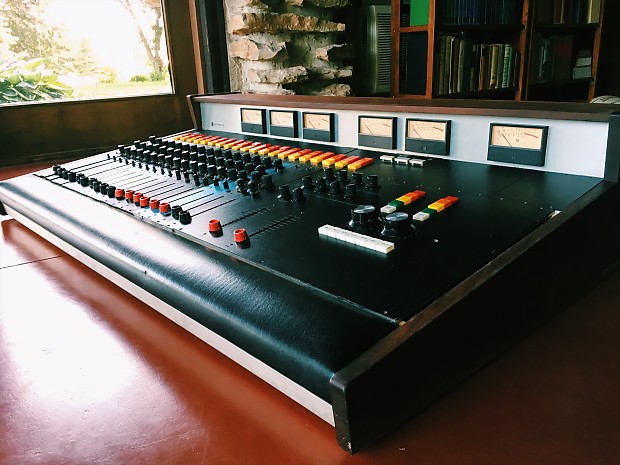
A 1968 Electrodyne Quad Eight Console
In 1967, the first console designed by Saul Walker’s Automated Processes Incorporated, otherwise known as API, was sold to Apostolic Studios in New York City. API has since gone on to develop some of the most sought after audio equipment, including their 1608 Console, 2500 Compressor and 500 Series Equalizers.
Consoles designed by Rupert Neve caught on in the 1970s, beginning with the A88 which was created for London’s Wessex Studios. This was the first of many Neve consoles which featured 1073 preamps, which have since become iconic. They can now be purchased as standalone rack units and 500 series modules. Rupert Neve went on to contribute his designs to several other reputable audio hardware companies, several of which we will cover later in this article.
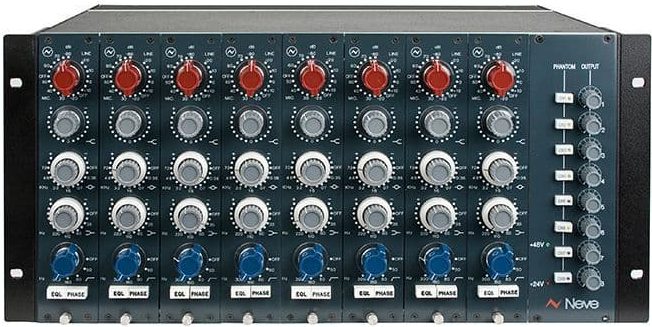
A rack full of AMS Neve 1073 Preamps
In 1979, England’s Solid State Logic, or SSL, released their SL 4000 E Series. In addition to a versatile equalizer, capable of both precise and broad-stroke moves, every channel on the E Series featured a dynamics section. The board also housed the classic stereo bus compressor, helping engineers create clean, punchy and cohesive mixes.
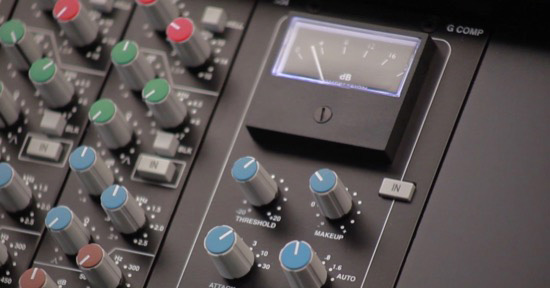
The famed SSL stereo bus compressor
If not for financial mismanagement, Electrodyne might have gone on to become more of a household name, sharing ranks with the “big three” of Neve, API and SSL. That said, through the decades there were plenty of additional companies that designed recording and mixing consoles featuring high quality channel strips. While music production has undoubtedly changed due to digital technology, there’s arguably no substitute for the sonics and flexibility a professionally designed and built console, loaded up with channel strips. Truthfully though, many of us don’t have the space and/or budget to justify housing a console in our studios, so it’s fortunate for us that many digital audio software makers have created channel strip plugins. Now we can harness the flexibility and sonic characteristics of classic channel strips without the exorbitant costs of maintenance and constantly running A/C — the latter can cost thousands per month.
Beneath is a roundup of my favorite channel strip plugins. I’ve also included tips on how I utilize them when recording and mixing.
1. Universal Audio API Vision Channel Strip Collection
This channel strip has it all — a beautiful preamp section based on the classic API 212L, the punch of the 225L compressor circuit, the precision and expressiveness of the 235L gate/expander along with the color and clarity of the 550L and 560L equalizers. The Vision Channel Strip is a supremely versatile tool, no matter what sound source you’re working with. It can add serious thump to kick drums, snappiness to snares, you can crush and saturate overheads or rooms, add detail and clarity to vocals… There’s nothing this channel strip can’t do well. I often use it in unison mode when recording with my Apollo x8p, a unique technology that allows me to harness the flexibility and sonic mojo of this and several other classic channel strips, all within a convenient single rack space audio interface.
Production Tip
When pushed hard, the 212L preamp has an impressively thick crunch to it. Utilize this powerful sound to add weight to drums, bass and other sound sources that need some low end heft.
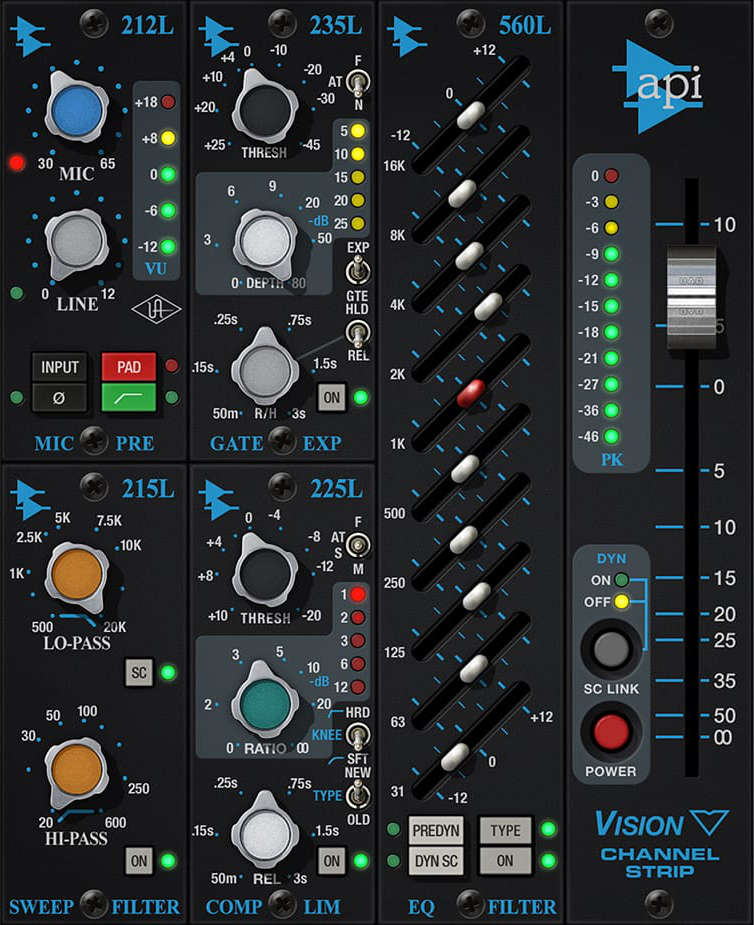
2. Brainworx bx_console Focusrite SC
Focusrite was born from the Beatles’ producer George Martin approaching Rupert Neve, hoping to acquire a preamp/equalizer module for his AIR Montserrat studio. This collaboration resulted in the Focusrite ISA-110, which had a transformer-coupled mic preamp paired with a four-band EQ plus high-pass and low-pass filters. This musical-sounding unit was just the beginning for Focusrite, which went on to craft sought after recording equipment including several consoles which were used to track bands including Green Day, No Doubt and plenty of other artists.
Thanks to Brainworx’s pioneering and patented Tolerance Modeling Technology, this plugin gives users access to the sound of 72 separate channels of the legendary Focusrite studio console, which includes ISA 110 equalizers and ISA 130 dynamics modules. Every one of bx_console Focusrite SC’s 72 channels offers a different channel from the console by modeling the slight channel-to-channel variances amongst the analog components.
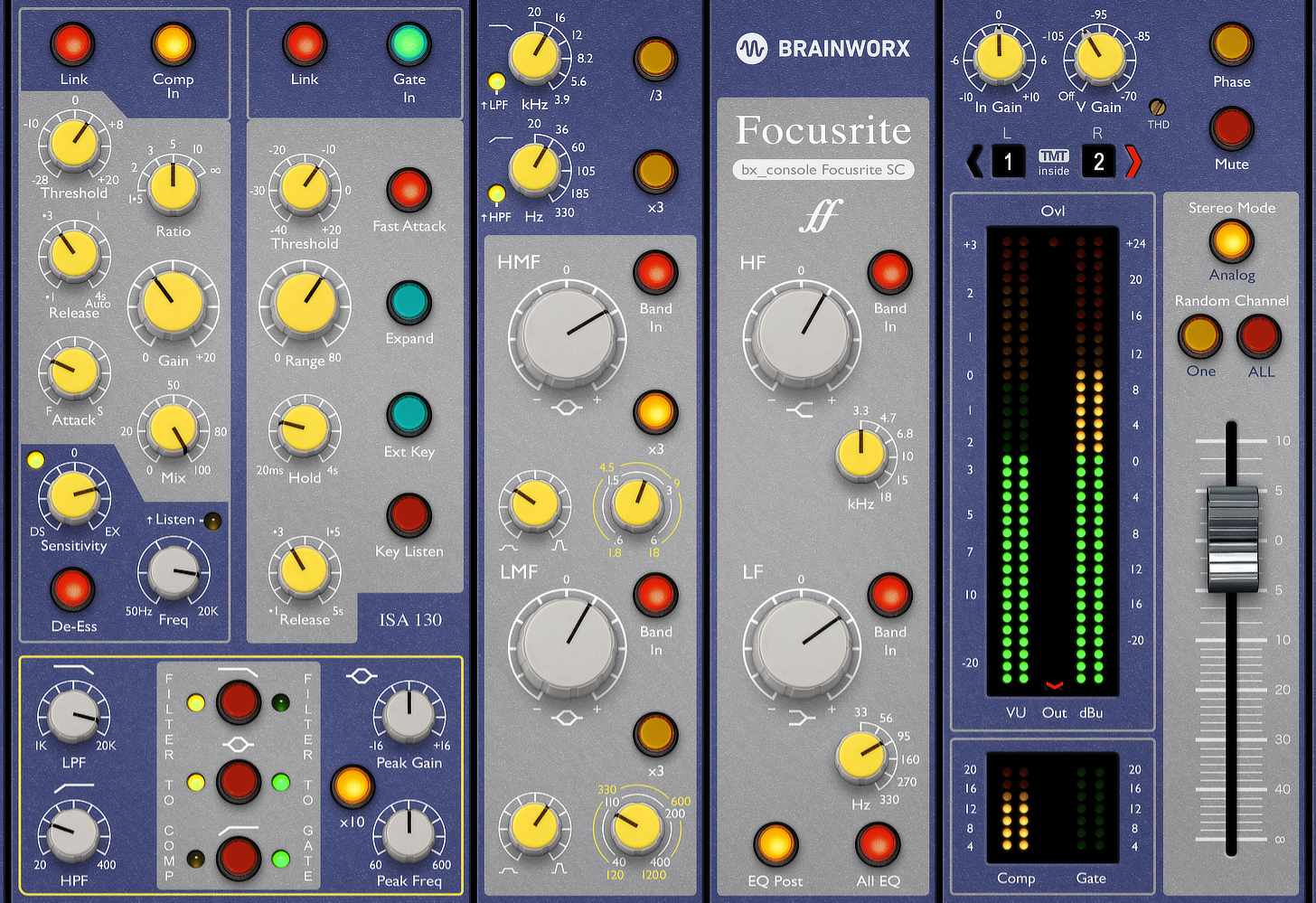
Mix Tip
The expander, which can be found within the dynamics module, is great for adding some “thwack” to lackluster kicks, snares, and room mics.
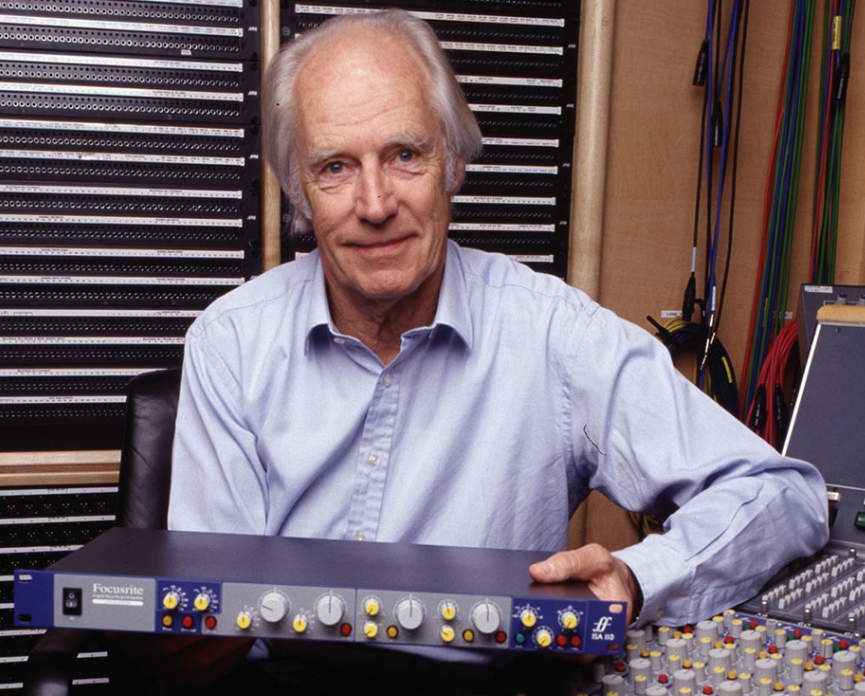
The late, great George Martin holding a Focusrite ISA 110 EQ and Preamp, seated next to a Focusrite console
3. Soundtoys Effect Rack (With a Bit of Creativity)
Okay, hear me out. While Soundtoys hasn’t (yet) offered a channel strip plugin per se, you can create your own by inserting several of their excellent plugins into their revolutionary Effect Rack. Start with the Radiator as a preamplifier and broad stroke equalizer, add Devil-Loc for any compression duties, and simply dial the mix knob back since it tends to be a very aggressive sound. Then, use the Sie-Q for more surgical equalization. While this approach lacks the precision of some of the aforementioned channel strip plugins, it more than makes up for it in vibe.
Mix Tip
One of the many great things about the Effect Rack is that you can place the plugins in whichever order you see fit. If you’d like to compress last (or first), you can absolutely do so. Or maybe you want to insert an instance of Decapitator (one of my favorite saturation plugins) to glue together all the processing you’ve applied to your track. Simply click and drag the individual plugins, listen to how the changes in order affect your signals, and tweak until you’re happy.
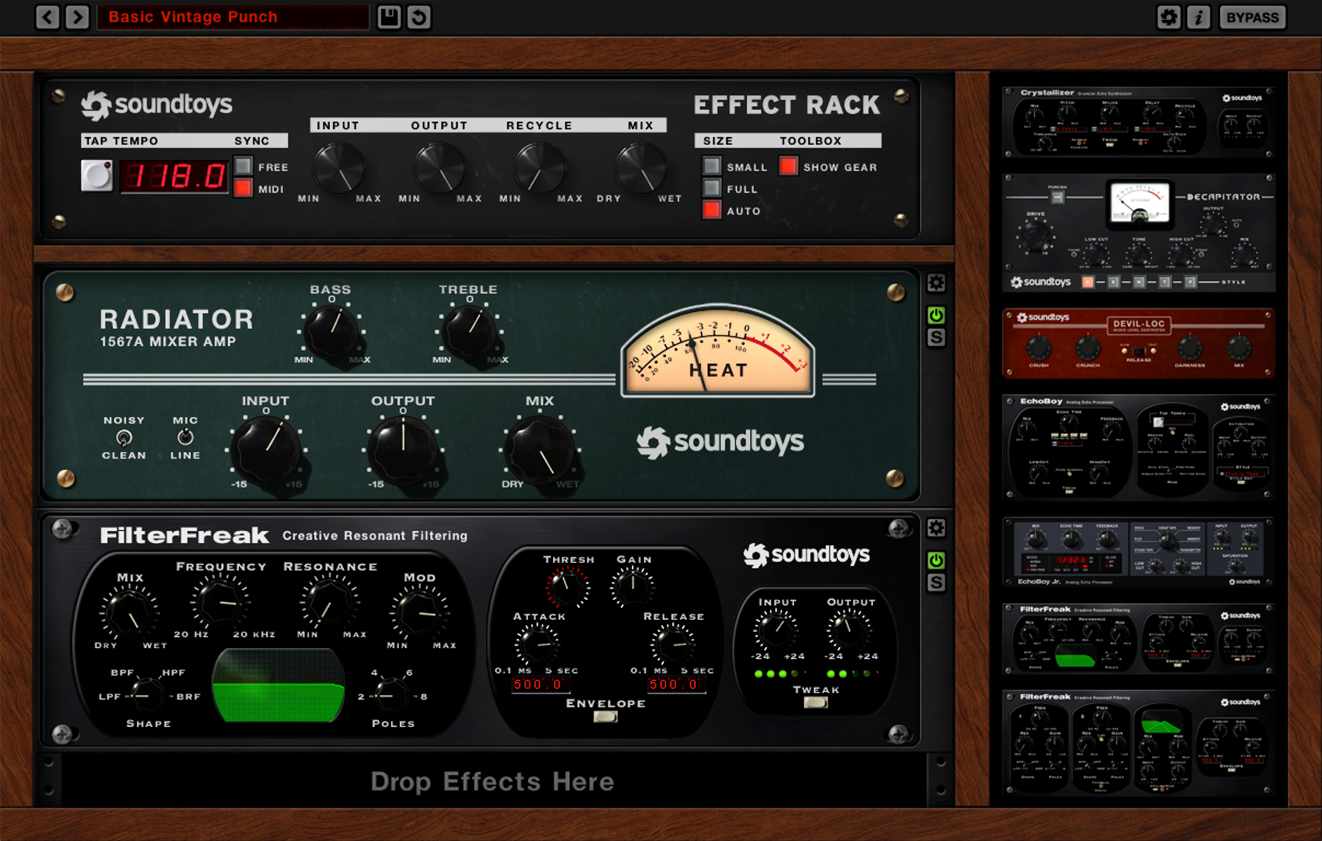
4. Brainworx bx_console Amek 9099
Perhaps the most feature-laden channel strip found within this roundup, the Amek 9099 from Brainworx/Plugin Alliance offers tons of precision, flexibility and fantastic sound quality, assuming you are willing to put in the time to orient yourself to the jam-packed user interface and learn what each of its impressive modules can do. Based on the 9098i console designed by Rupert Neve, this plugin sports a compressor, limiter, clipper, 4-band EQ, wide-ranging high-pass and low-pass filters and a newly designed expander/gate.
While audio quality takes precedent over visual aesthetics, the plugin was recently updated to include three separate “skins.” Access used, new, and dark modes by clicking “UI” to the top right and selecting your preference.
Mix Tip
Tighten up unruly low end by utilizing the mono-maker feature, which converts all frequencies beneath the level at which it is set into mono, preventing an overwhelming amount of low frequencies from eating up precious headroom in the sides. This allows for a tighter, clearer stereo image.
Additionally, the limiter section has a “clip” option, which can add saturation when driven hard. If you’ve got a track that could benefit from an extra bit of harmonic content, you might want to consider this feature.
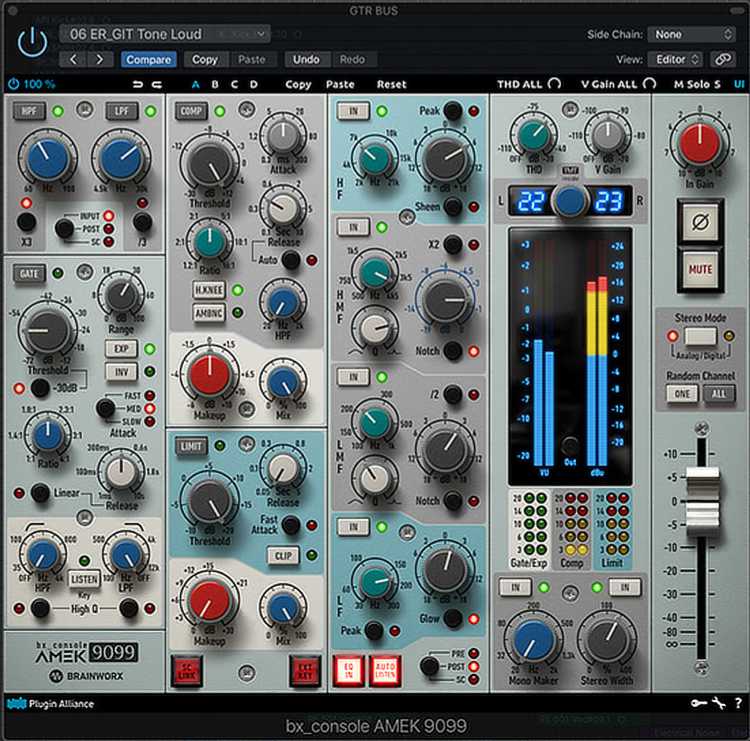
5. iZotope Neutron 3
Marketed as “the channel strip of the future,” Neutron 3 doesn’t look anything like a module found within an analog console, but it remains an impressively robust music mixing tool. You could likely strap an instance of Neutron 3 on each and every track within a session and not need to reach for another plugin while mixing, save for perhaps time-based effects such as reverb and delay. Neutron 3 also has several features that none of the previously mentioned channel strips do. The AI-powered Mix Assistant balances your track volumes, suggesting an initial level mix after one listen, and the Masking Meter lets you know which tracks have conflicting frequency-based content.
Mix Tip
While the Mix Assistant and Masking Meter are wonderful tools, I never treat them as gospel. I’ll analyze my tracks with them, use the feedback that they provide, and make changes based on my own preferences. While I gladly incorporate AI-assisted plugins into my workflow, they are no substitute for my own musical intuition.
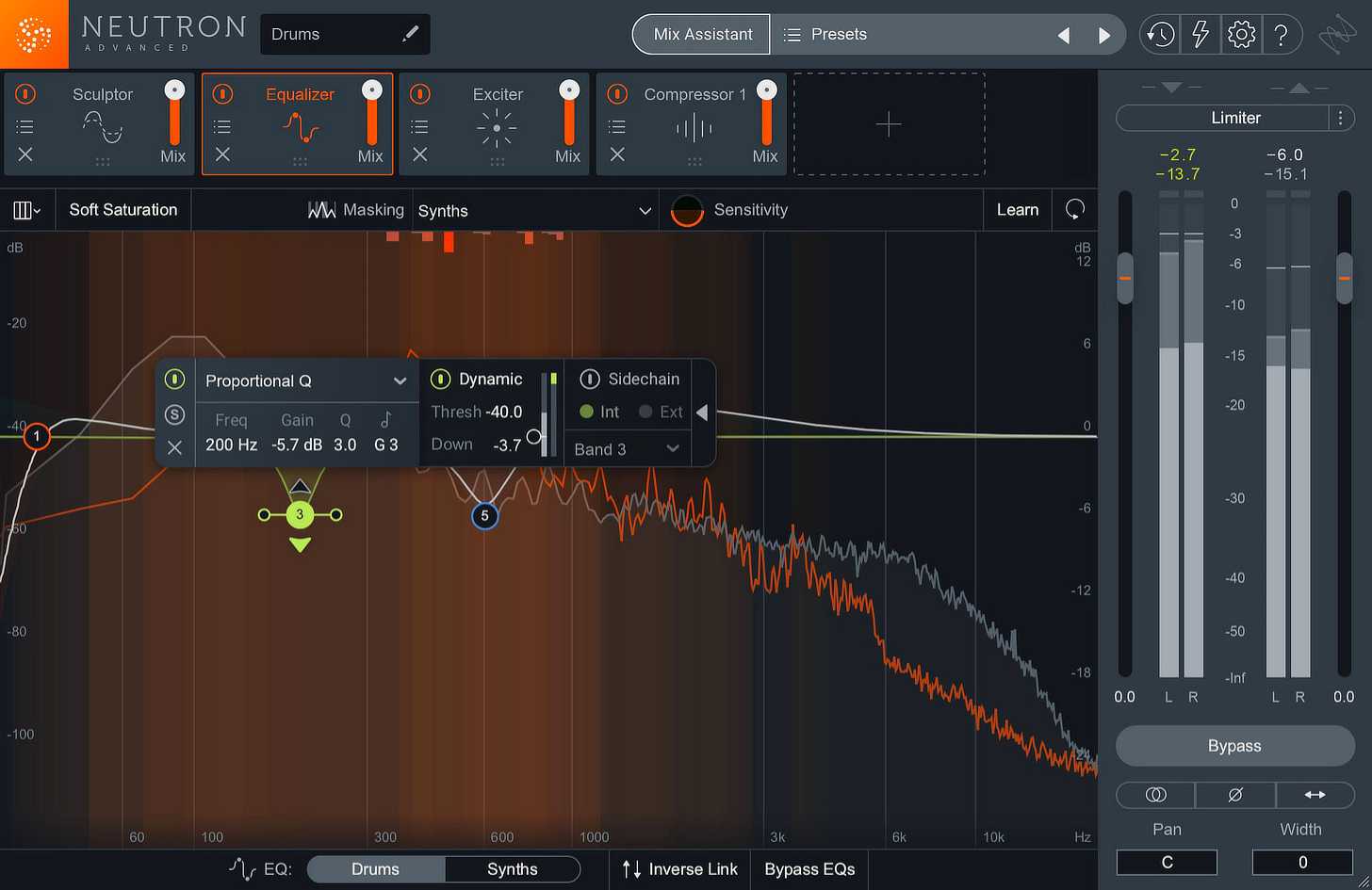
6. Brainworx bx_console SSL 4000 E, 4000 G, and 9000 J
If you’re after authentic emulations of the channels strips found within 3 legendary consoles from Oxford, England’s very own Solid State Logic, look no further than these superb plugins from Brainworx. Harness the power of Tolerance Modeling Technology (TMT), which allows you to mix with 72 slightly different analog channels, capturing the subtle nonlinear characteristics of these sought after modules.
There are mostly subtle sonic and workflow differences between the 3 different consoles, but each of these give users the snappy dynamics, subtly colorful & somewhat surgical equalization and generally clean sonic characteristics of the original SSL products. I’ve found the 9000 J, which was viewed as an improvement over the 4000 series consoles at the time, to have a more extended low end and a slightly more sparkly high frequency response.
Mix Tip
Try strapping one insert of an SSL channel on each of your tracks within a mix and listen to how the subtle coloration and tight dynamics beloved by users of the original E, G and J consoles affects the overall fidelity of your production.
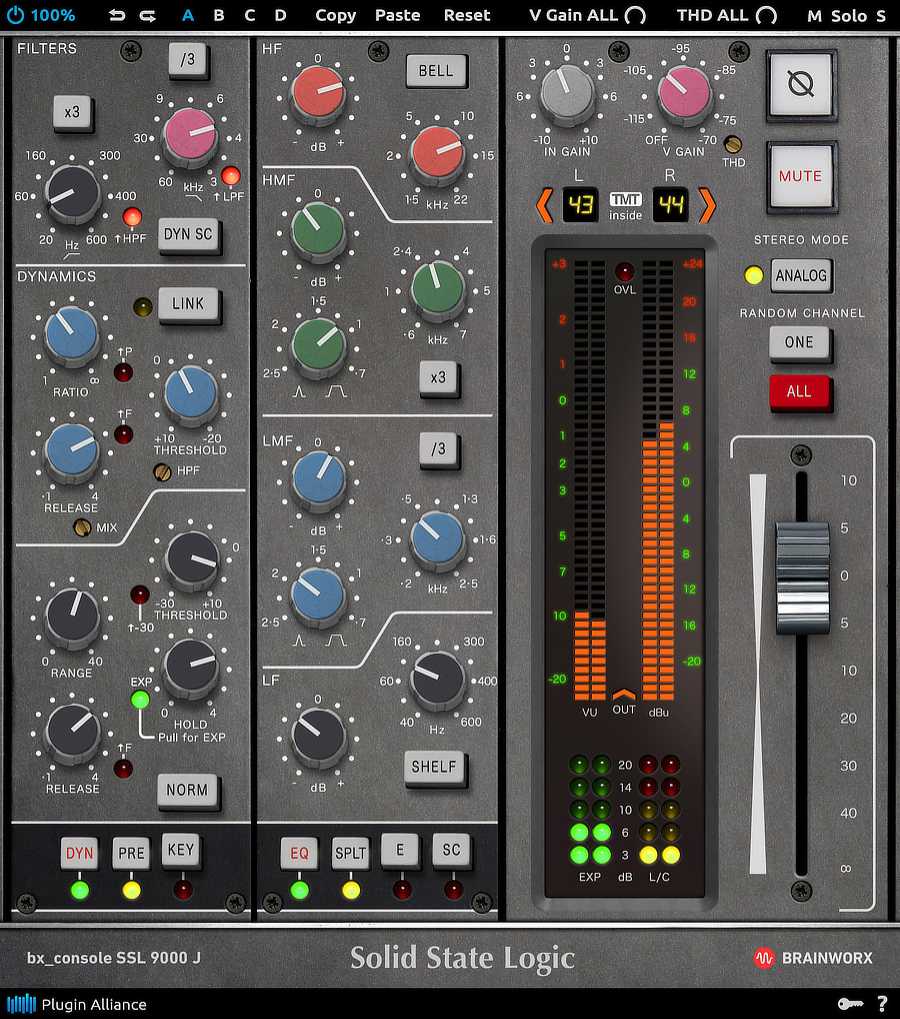
7. Waves Scheps Omni Channel
Andrew Scheps would only stamp his name on something truly exceptional, and that’s exactly what Waves have created in collaboration with Scheps himself in the super versatile Omni Channel. This thing has everything you could hope for in a channel strip, and quite frankly, more then you’d likely ever need. There’s a preamp section that allows you to add harmonics, a high and low-pass filter, an extremely tweakable four-band EQ, a dual-band de-esser, a compressor with VCA, FET & optical modes plus a gate/expander. These modules can be moved around, so if you’d like to compress before EQ, for example, that can be done by simply dragging the compressor module and dropping it in front of the equalizer. The output section features both input and output levels, as well as a limiter. The Omni Channel is truly a Swiss Army Knife plugin — capable of quickly and elegantly shaping the dynamics and tone of your tracks or subgroups.
Mix Tip
Each module can be used in ST (stereo), DUO (dual mono), and MS (mid/side) mode. Stereo is self explanatory, processing the left/right exactly the same, but DUO allows the user to treat the left and right channels separately, making it great for stereo signals that have harmonic or dynamic discrepancies between the left and right channels (think drum overheads or even instrument subgroup tracks).
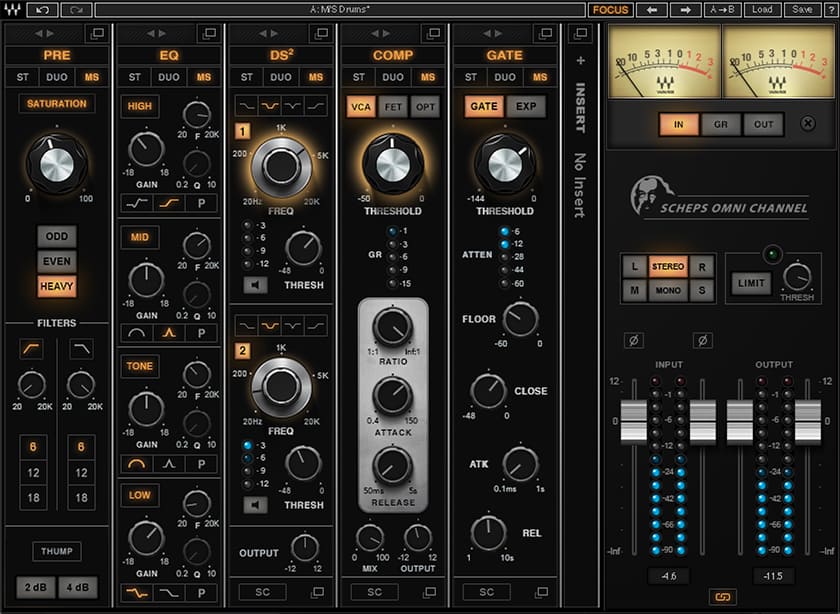
8. UAD Century Tube Channel Strip
Harkening back to the days when analog channel strips were more streamlined, lending themselves to creative decision making while recording rather than waiting to “fixing it in the mix,” the Century Tube Channel Strip is a versatile signal processing tool without ever feeling cluttered or confusing. The sound is warm, clear and thick similar to the vintage tube gear that inspired it, and the GUI is welcoming and simple. You can almost feel the chunky black knobs beneath your fingertips.
The Century Tube Channel Strip features a preamp section with low and high gain settings, mic or line level selector, a low cut, polarity invert and a pad. The EQ is wonderfully intuitive and musical sounding, featuring one fixed band at 10 kHz, another at 110 Hz and a sweepable midrange band that goes from 300 Hz to 7.2 kHz. The opto leveler couldn’t be simpler, featuring only a single knob to control the amount of compression. It works wonders for subtle taming of sources like bass and vocals, but can also apply grit and attitude when driven harder.
Recording and Mix Tip
As I mentioned, the preamp module features low or high gain settings, with the former complimenting modern condenser microphones and the latter optimized for vintage ribbons or dynamic mics. Consider this if you’re recording though your Universal Audio interface and taking advantage of the ingenious Unison technology.
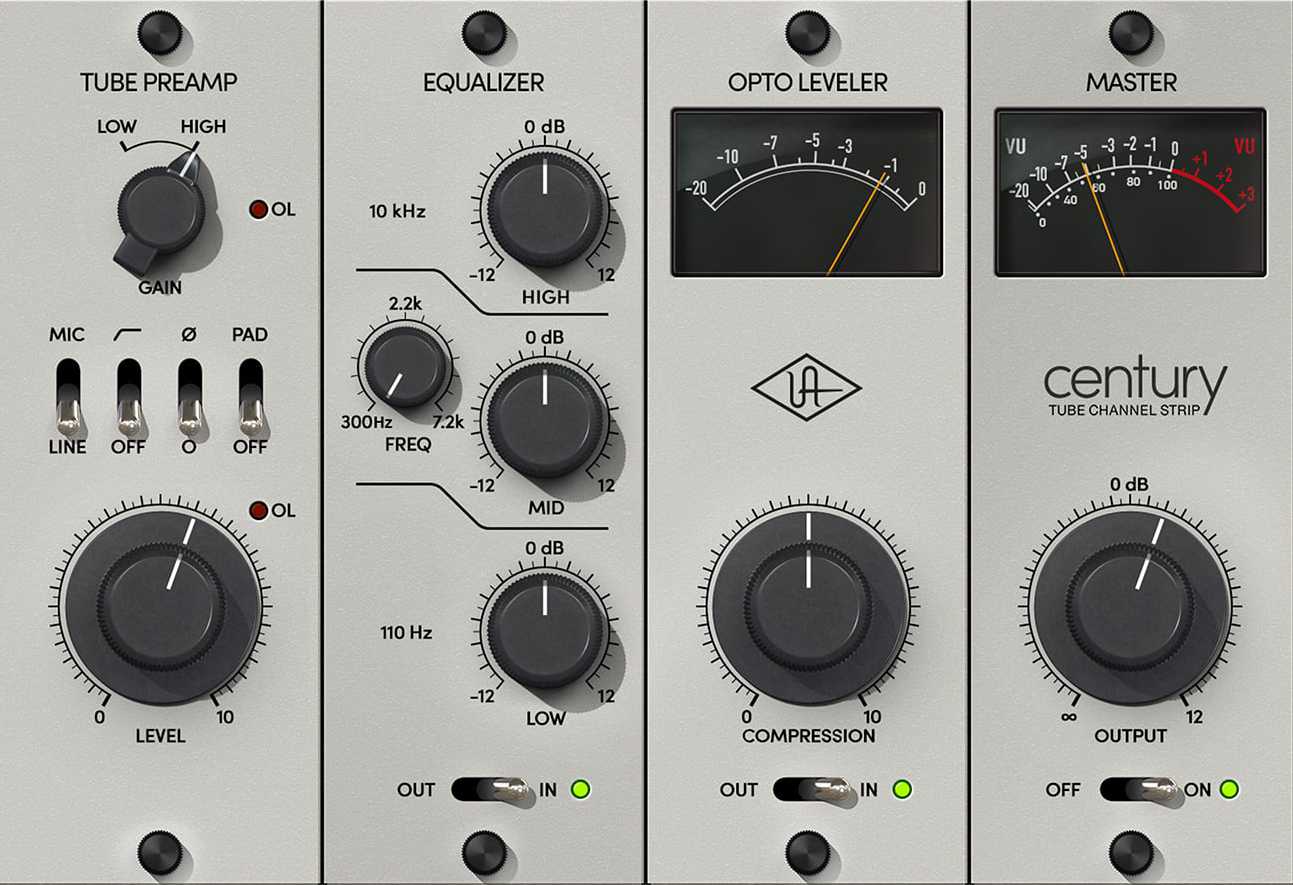
9. Slate Digital Virtual Analog Bundle/Virtual Mix Rack
This is cheating a bit, as the Slate Digital Virtual Analog Bundle isn’t modeling any one channel strip. Rather, it includes a diverse collection of preamp, equalizer and compressor modules emulating classic hardware that can be configured exactly to your liking within Virtual Mix Rack (VMR). It’s undeniable that users can create channel strips perfectly suited to their tracks with this powerful software set. While the actual company names aren’t used, hardware units from SSL, Neve, Empirical Labs and others have been meticulously studied and transformed into plugin modules that can be inserted and swapped with ease. Slate Digital also developed several modules in-house, including “Revival” — the two knob unit which borrows the best sonic aspects of tubes, tapes and transformers — making VMR one of the most diverse and configurable channel strip options currently available.
Mix Tip
What’s so great about using VMR is you can use up to 8 modules, making it far more versatile than most other aforementioned products. I like to start with a preamp module, employ a bit of subtractive EQ, use two compressors in series so that neither one is doing too much heavy lifting and then add another finalizing EQ for adding clarity, warmth or whatever may be lacking. Even more helpful is that most of the modules have a dry/wet blend control so you can really dial in how aggressive you want to be with the processing.
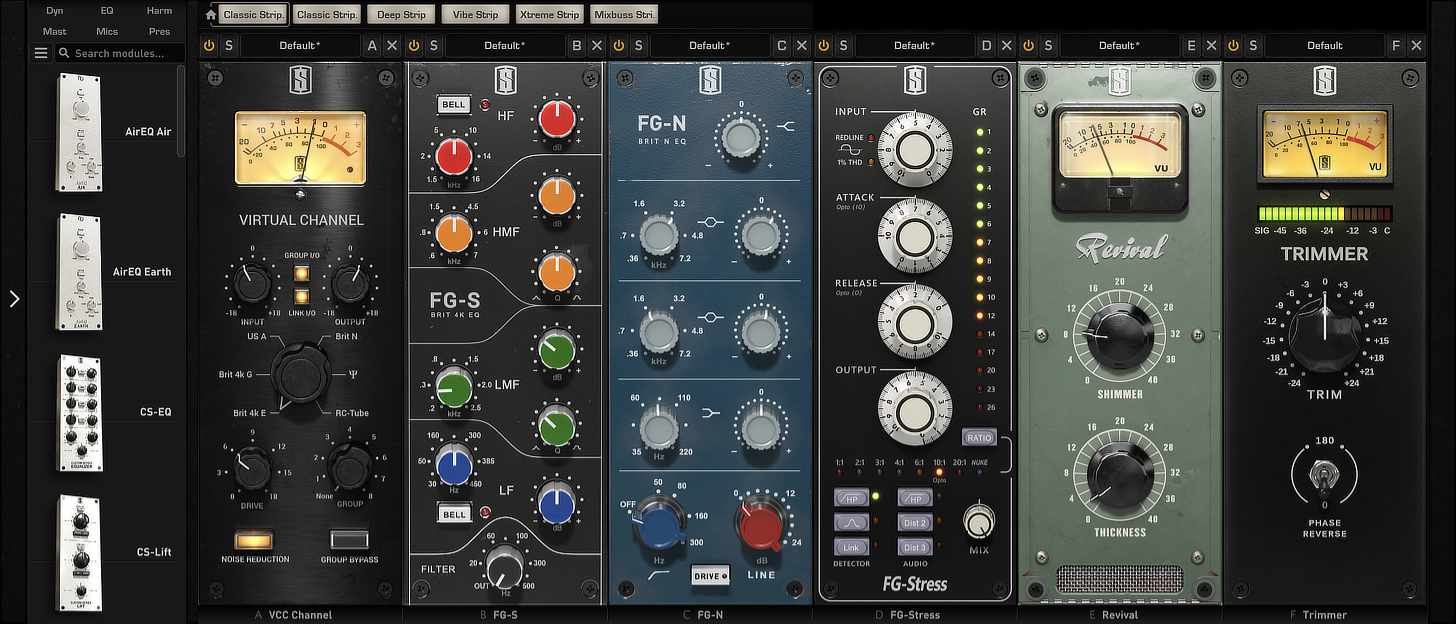
10. UAD Avalon VT-737 Tube Channel Strip
Not all channel strips are created equally. While the original Avalon VT-737 was a hefty rack mounted unit loaded with tubes, rather than a module built into a console, that didn’t stop it from becoming one of the most widely used pieces of hardware for recording pop, hip-hop and R&B.
The preamp is clean and detailed, perfect for capturing the energy of modern pop vocals. It also works well for recording thick, powerful DI bass. The compressor section is more transparent than many other popular hardware dynamics processors, which again, is great for preserving the integrity of the original performance without coloration (if that’s what you’re after). Personally speaking, the EQ section of the Avalon is where the magic happens — it’s simultaneously musical and surgical, and features a 32 kHz “air band” that adds a subtle shine to vocals, acoustic guitar and drum overheads.
Mix Tip
The EQ section can be conveniently placed before or after the compressor. Don’t forget to see how this affects the overall sound, as aggressive additive equalization at a specific frequency before compression can have the tendency to sound unnatural and over-compressed, especially at that specific frequency.

11. Softube Summit Audio Grand Channel
Combining emulations of two behemoth rack-mounted hardware units from Summit Audio, the Grand Channel pairs the EQF-100 full-range equalizer and the TLA-100A compressor, adding several plugin-only features to boot.
The EQF-100 has sort of a Pultec vibe to it, sporting a silky top end and a thick but musical low frequency response. The four bands each have 6 selectable frequencies with a bandwidth control, so it can actually get precise when needed. The high and low-pass filters are transparent, and are helpful for removing clutter at the top and bottom of the frequency spectrum.
The TLA-100A is a no-nonsense tube leveler, featuring only “fast” and “slow” attack and release settings, overall gain and gain reduction, as well as the ability to choose between an internal or external sidechain. It might not be the most exacting dynamics processor, but for subtle general compression duties, it shines on bass, vocals, guitars and certain percussive sources.
Mix Tip
In addition to the wonderfully tubey equalizer and compressor, which can be placed in whatever order users need, the Grand Channel features a low cut all the way up to 600 Hz that can be applied to either the input or the detector circuit. This is great for preventing the compressor from overreacting to an abundance of low frequencies. It also has a saturation knob, which works wonders for adding grit to drums and bass.
The Grand Channel was one of the first plugins of its kind to feature a dry/wet blend control, so you can dial in more extreme settings and then scale the overall mix back to taste.
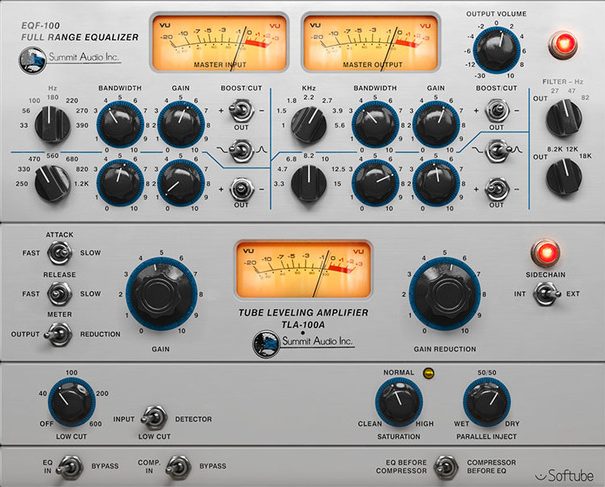
12. UAD Manley Labs Voxbox
While the original Voxbox hardware (and subsequent plugin emulation by Universal Audio) were designed to serve as an all-in-one solution for recording and mixing vocals, don’t let that stop you from deploying it on everything else, including piano, strings, bass and even subgroups.
One of the unique features of Voxbox is the ability to tame sources before the preamp using the on-board optical preamp. The compressor itself (when active) is always set to a 3:1 ratio. Unless pushed to extreme settings, it will stay relatively smooth and transparent. The preamp features input level, a stepped gain control, a low cut, polarity invert and a mic or line level switch. The beautiful 3-band, Pultec-style equalizer is perfect for broad-stroke tone sculpting. Lastly, the de-esser is deceptively flexible despite having minimal controls, and can be turned into a colorful limiter when the limit 10:1 option is selected.
Mix Tip
A de-esser is simply a compressor targeted at a specific frequency range, making it really useful on the Voxbox for subtly taming harshness in guitars, cymbals, pianos and vocals, of course. As long as you know where harshness is occurring, this de-esser can elegantly polish your tracks.

13. Lindell Audio 80 Series Channel
Neve Electronics brought 80 series consoles to market in 1969. Since then, they’ve been almost universally adored for their flexible workflows and unique sonic characteristics. Lindell Audio has painstakingly replicated modules from the 8028 and transformed them into the 80 series channel, available through Plugin Alliance. It sports preamp and equalizer sections based on the legendary 1073 & 1084 hardware and a compressor based off the colorful 2254. These are paired with a super flexible gate module. Patented TMT modeling captures the sonic characteristics of 32 separate channels. The 80 series channel is a stunning processor for pretty much whatever you throw at it, but I’m partial to using it on drums. The top end is pristine, the low end is thick and the 1073/1084 preamp and 2254 compressor can be pushed aggressively to unleash an unmistakable thump that’s rich in harmonic content and attitude, making it a perfect companion for kick or snare drum.
Mix Tip
Engage “nuke mode” on the compressor for crunchy compression that brutalizes transients beyond recognition. This works great in parallel for kick, snare, rooms, aggressive vocals or blistering fuzz bass.
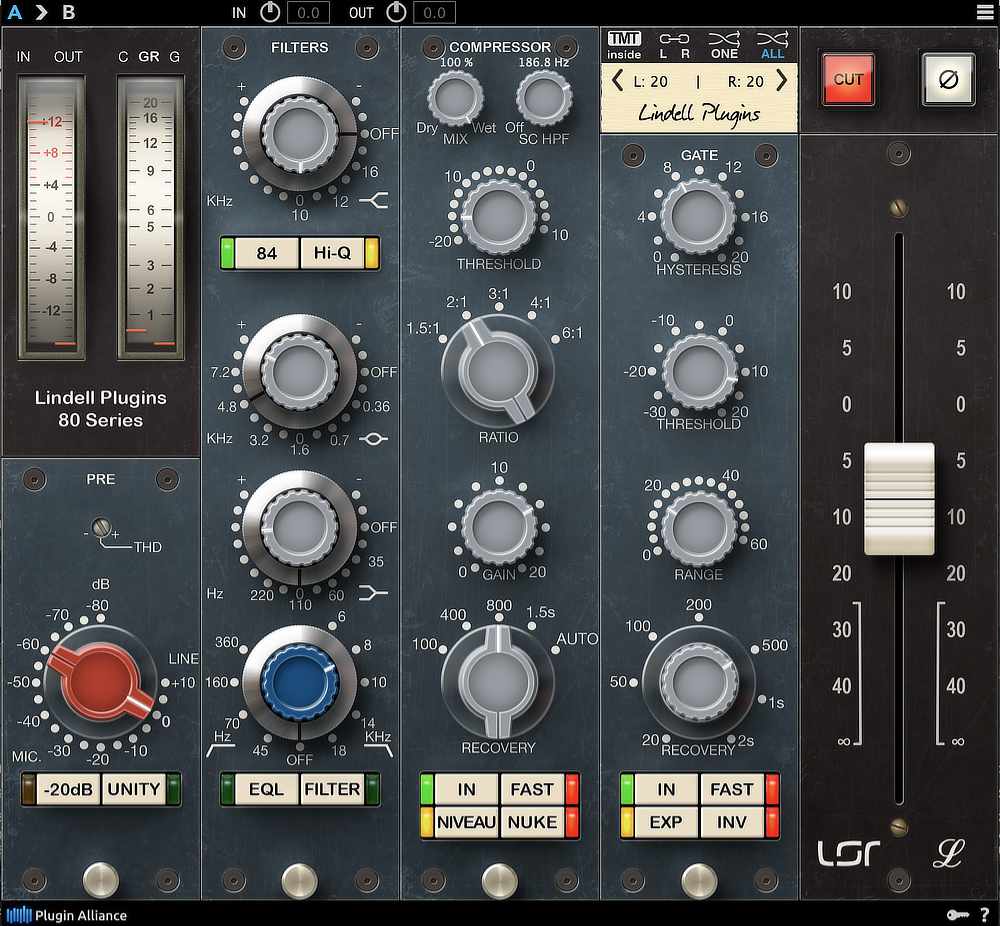
14. Kit Plugins BB N73
Released in collaboration with the legendary Blackbird Studios in Nashville, the BB N73 captures the essence of twelve Neve 1073 units that are in use at John McBride’s renowned studio. The BB N73 comes with some extras that you won’t find on other 1073 plugin emulations, including but not limited to:
- Input and output trim to provide additional gain staging.
- Auto gain: as you add gain on the mic pre, the fader level now adjusts the output automatically to maintain dB level.
- Continuous gain optionally removes the notched movement of the mic pre.
- The resizable GUI allows you to click and drag the bottom right corner to change the size of the plugin.
- Fader color allows you to change the color of the fader between black, silver, red, blue and teal.
- Oversampling allows you to select from x2, x4 and x8.
I popped the BB N73 on a kick drum, and I was immediately impressed with the thick, musical low end of this plugin — not to mention the colorful saturation you can get when you push it a bit.
Mix Tip
The master buss mode emulates the characteristics of using an analog console to sum your tracks during mixdown, and I put it through its paces on a guitar driven rock song I’m mixing. I boosted about 1 dB using the high shelf and even less than that at 80 Hz. I quite enjoyed the clarity and slight low end heft this plugin imparted onto the mix. I’ll definitely be using it for individual tracks, subgroups and during mixdown.
